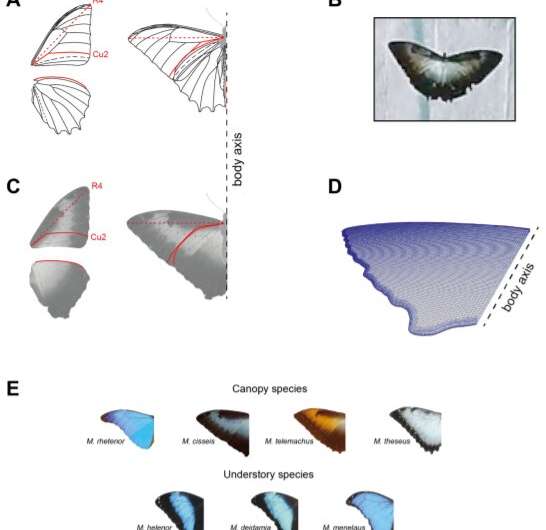Determining the wing shape of the gliding Morpho butterflies for our CFD study. (A) The typical vein architecture of Morpho butterfly wings was use as landmarks to standardize the relative position of the fore- and hindwing during gliding flight. The axis linking the wing base to the vein junction R4 (red dotted line) was positioned perpendicular to the body axis. The front margin of the hindwing was then placed against the Cu2 vein of the forewing (red lines). (B) The overlap between forewing and hindwing in (A) was determined based on the overlap during gliding flight, estimated based on the top view camera in the semi-field setup. (C) Cropped images of the wings from the filmed specimens were used to build the realistic gliding wing shape. (D) Three-dimensional model of the gliding wing, including the surface mesh used in the CFD simulations. (E) In-glide wing shapes of the species studied with CFD simulations. Credit: DOI: 10.1126/science.abh2620
Some morpho butterflies live and fly high in the canopy of the Amazonian rainforest, and have evolved into highly-efficient gliding flyers. These results revealed by Wageningen University & Research and published in Science show that the switch from the understory to the canopy habitat strongly influenced the evolution of flight in morpho butterflies.
The large Amazonian morpho butterflies are famous for their blue iridescent wings and are among the largest flying insects. Most morpho species fly close to the ground in the dense understory of the rain forest, but some species live and fly high in the canopy. For several months in the Peruvian jungle, scientists used high speed cameras to film the flight of morphos in the wild and in captive condition to record the flight of both understory and canopy species.
Flight of morphos
The butterflies from the understory show a powerful fast-flapping flight, while morphos from the canopy display majestic highly-efficient gliding flight. "The fast flapping flight is likely advantageous to move through the dense vegetation," says researcher Florian Muijres. "A gliding flight enables the canopy species to cover large distance at low energetic cost in the open canopy habitat."
Such divergent flight evolution may simply result from behavioral differences, or changes in morphology. Back in the lab in the Netherlands, the researchers modeled their aerodynamic performance using computer simulations, in collaboration with fluid dynamics engineers of Maritime Research Institute Netherlands.
Aerodynamic models are unequivocal: wing shape plays a crucial role for gliding efficiency, but surprisingly different canopy species achieve increased gliding efficiency in different ways. Some have more slender wings and others more triangular wing shapes. The resulting enhanced gliding efficiencies are similar.
Biodiversity
The study revealed how natural selection imposed by different microhabitats can drive the evolution of flap-gliding flight by jointly altering wing shape and flight behavior. "Our work also nicely illustrates that the diversity of habitats hosted by the rain forest is key in the evolutionary diversification of species," says researcher Camille Le Roy. "The integrity of the forest is thus intimately linked to the maintenance of biodiversity."
More information: Camille Le Roy et al, Adaptive evolution of flight in Morpho butterflies, Science (2021). DOI: 10.1126/science.abh2620
Journal information: Science
Provided by Wageningen University
























